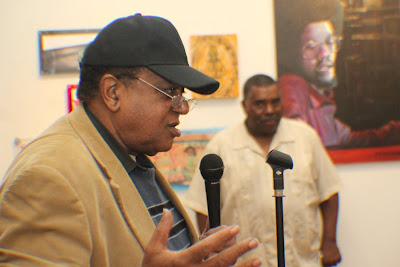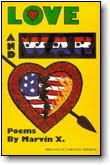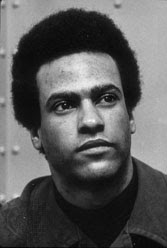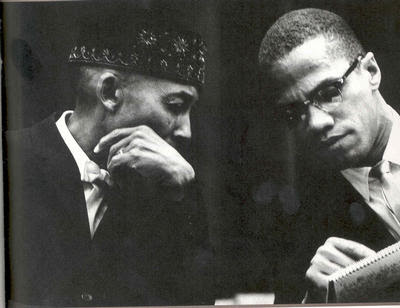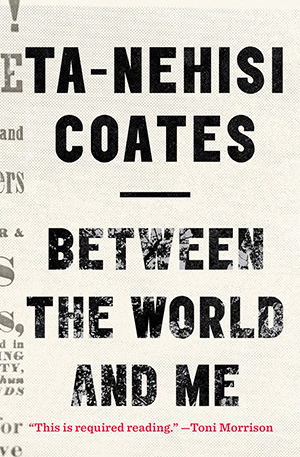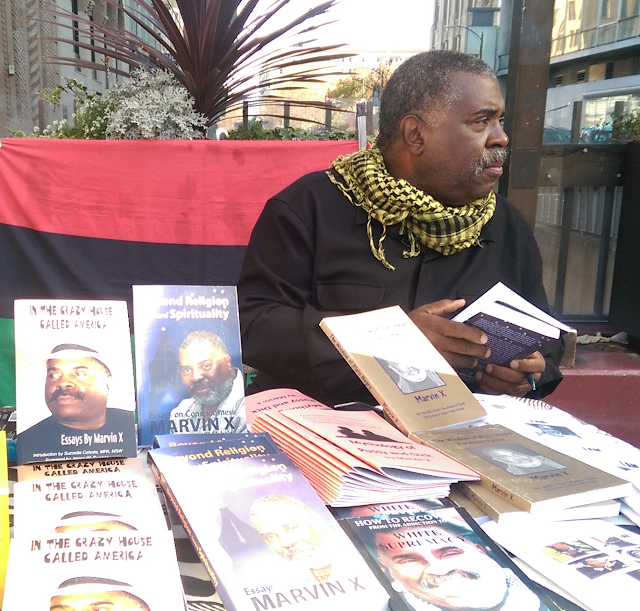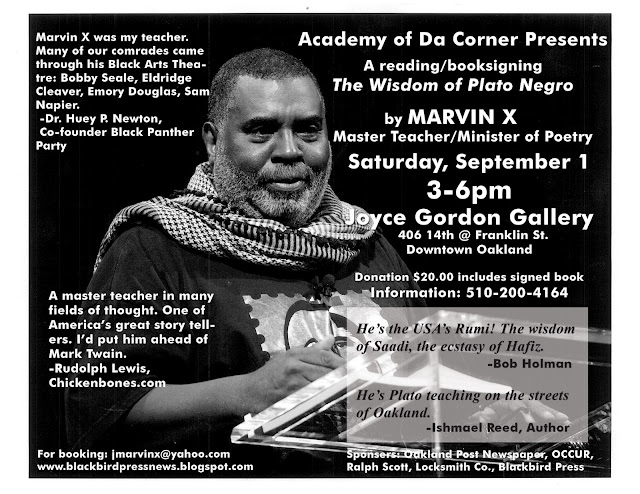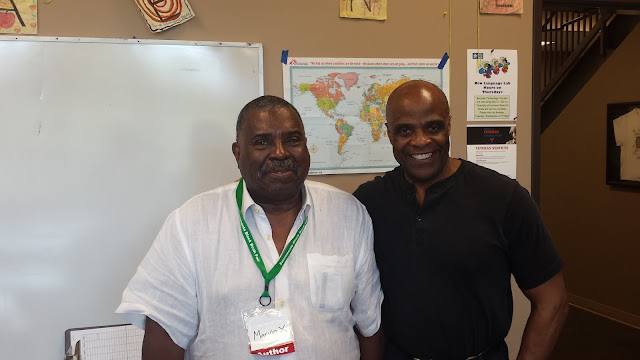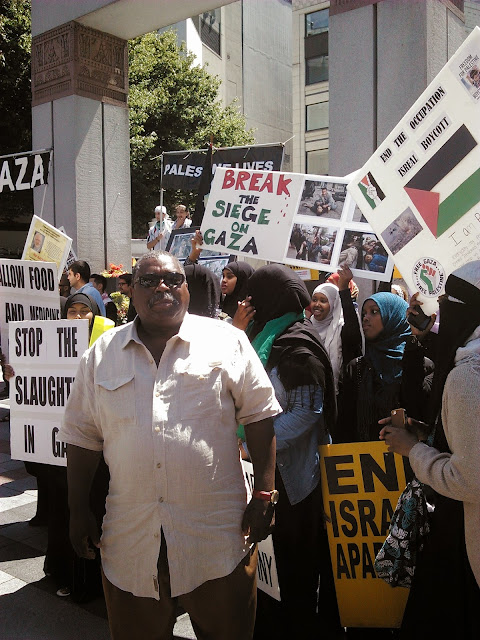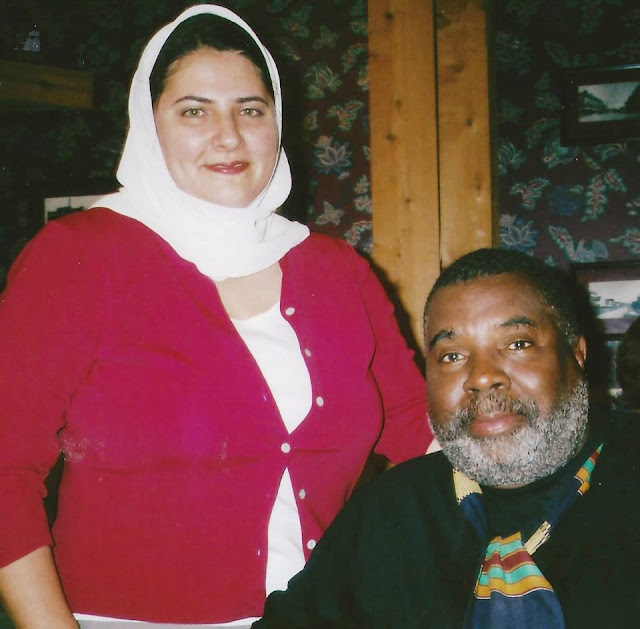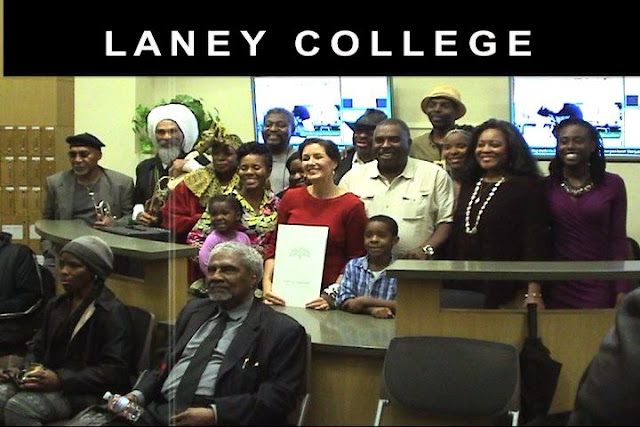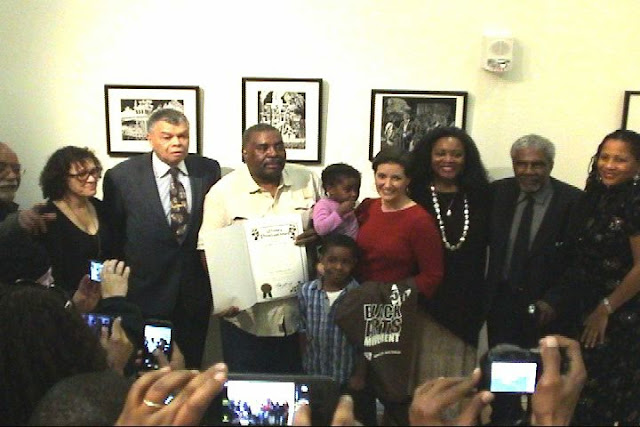Note: "Africa has a third of the world's languages with less than a seventh of the world's population. By comparison, Europe, which has about an eighth of the world's population, has only about 300 languages" (Christian Science Monitor).
It is estimated, in fact, that Africa has possibly 3,000 languages and counting.
Further, the degree to which African languages have been incorporated into American English is significant. The number of African languages from various ethnic groups that were brought to the Americas as slaves is also huge.
Many slaves who came to these shores from Africa had written language and many were also Muslim and writers in the Arabic language. It is also interesting that many Africans came to the Americas speaking not one but several languages.
There are 1,250 to 2,100 and by some counts over 3,000 languages spoken natively in Africa, in several major language families....
There are several other small families and language isolates, as well as obscure languages that have yet to be classified. In addition, Africa has a wide variety of sign languages, many of which are language isolates.
About a hundred of the languages of Africa are widely used for inter-ethnic communication. Arabic, Somali, Berber, Amharic, Oromo, Swahili, Hausa, Igbo, Fulani and Yoruba are spoken by tens of millions of people. If clusters of up to a hundred similar languages are counted together, twelve are spoken by 75 percent, and fifteen by 85 percent, of Africans as a first or additional language ( Wikipedia). The article below is by Dr. Katherine Harris at Central Connecticut State University and written in 1997. It was largely written in response to the "Ebonics" debate in the United States at the time - particularly in California.
Ebonics, a blend of 'ebony' and 'phonics' referring to what is commonly known as 'black English', was coined by psychologist Robert Williams in 1973.
....The Oakland (CA) resolution called for federal bilingual education funds to support its Ebonics program, asserting that African-American pupils were on the same footing as Asian-American, Latino-American, Native American, and other pupils 'who come from backgrounds or environments where a language other than English is dominant,'
Federal authorities objected that the Ebonics program called for language maintenance, whereas federal bilingual education funds are earmarked only for transitional, not maintenance, programs (Ebonics Controversy).
With specifics, Dr. Harris writes of the breadth of African languages brought to the U.S. and their infusion into the American culture.
Harris also offers examples of the how African languages over time have been incorporated into American English and how some of the African culture coupled with its languages have been maintained within the African American communities.
Our youth are not taught this rich history in the American schools. In fact, we should be significantly exploring the African influence in our lives in addition to Greek and Roman impact. Our youth and adults - all of us - should be taught the vast array of African cultures and languages to include Arabic influence as well.
The article below is long but was also edited - for the original go to Africa Update. I found Dr. Harris' article incredibly informative and fascinating. Enjoy!!!
Heather Gray
African Languages and Ebonics
by Dr. Katherine Harris Central Connecticut State University 1997
The controversy over the "Ebonics" issue may have abated. The discussions have revealed again, however, a duality that has shaped the experience of the descendants of Africans who arrived as captives in the Americas. On one level, by emphasizing the enhancement of African American students' English skills, the Oakland Unified School District (OUSD) has pointed to the quest for academic literacy viewed as a tool out of socio-economic deprivation. On the second level, the resolution has accented a need for historical literacy by identifying the languages of West Africa and the Niger-Congo River confluence as the ancestral "historical and cultural base" of African American speech in the 1990s.
The Ebonics debate, however, has brought to the forefront questions regarding the distinctions between the forms of oral communication, slang, dialect, and language. Moreover, one might ask, why choose the term "Ebonics," composed of "ebony," which is English, and "phonics," which is Greek. Though "Ebonics" has been translated literally as "Black Sounds," the use of a Greek/Latin expression seems incongruous when trying to connect African American speech to African linguistic bases.
However, the core issue of redressing scholastic inequities must not be lost. The 1990s debate on segregation in public educational institutions and unequal distribution of public finances for predominantly black facilities dates from the 1790s. African American families founded schools for their children in New York City during the 1790s and 1800s when it became apparent that the local government was reluctant to provide educational access.
Boston schools had been segregated and often unequal in terms of resources since 1798. The busing crisis in the 1980s briefly interrupted this pattern. But the need for education for Black children also prompted l9th century African Americans to form the North African School and the South African School in Hartford, Connecticut.
In 1971 The Center for Applied Linguistics, based in Washington, D.C., developed a series of "dialect readers" called "Black English" as parts of a reading program. Parents criticized the strategy heavily. Indications are that the readers did not use African language correlations. The "dialect readers" contained phonetic approximations of expressions and were difficult for children to use. The readers are not currently in print. However, scholars continued their investigation of "Black English."
....While the communities divide and debate the "Ebonics" issue, fearing that it is another trap to miseducate youth, at the core of the debate is the need to recognize and build on the reservoir of intellect, creativity and linguistic formations African American children bring to the classroom via their African heritage. Yet these language formations require careful unraveling.
Such expressions as, "I says," or the double negative, "ain't no" (for example Marvin Gaye and Tammie Terrell "Ain't no Mountain High Enough") can be heard in the British Isles and sometimes are considered archaic English rather than poor grammar. African American speech patterns can include such unique features as rhyme, rhythmic patterns, repetition, gestures, parables encoded in speech, alliteration and tone.
But the sources of other expressions - "pacific" instead of "specific,""baf" instead of "bath,""mines" instead of "mine,""womens," or "mens" instead of "women" or "men,""skreet" instead of "street" are more difficult to pinpoint. Moreover, such verb forms as "lernt" instead of "learned" may be of German or Dutch origin. It is important to remember African American linguistic formations have been influenced by a multiplicity of European languages - English, French, Spanish, Portuguese, German, Dutch, and even Danish from the Danish West Indies, now U.S. Virgin Islands and St. Thomas. None of these observations preclude the fact that some words are pronounced perhaps incorrectly and/or uniquely, and this tendency can be found in communities across racial, ethnic and regional lines.
Despite the assault on African languages and cosmological traditions during slavery, it is worthwhile to explore points raised by the "Ebonics" discussion. The OUSD coined the phrase, Pan-African language system, without defining it. The concept is, nevertheless, useful. "Pan" refers to many, and it is likely that captured Africans came from a number of linguistic regional backgrounds, including the West Africa region.
The language debate might take into consideration the geographical configurations of Africa in the 1500s through 1800s when the slave trade occurred. Captured Africans, the ancestors of contemporary African Americans, came from areas where people and cultures defined polities that were usually multiethnic and multilingual. The following examples illustrate this point.
The Mandinka (Mandingos) and Malinke lived in what is now Senegal, Guinea, Mali, the Ivory Coast and Burkina Faso (Upper Volta).
The Wolof were in what is now Gambia and Senegal.
The Mano communities were in northern Liberia and southern Guinea. The Mende and Temne lived between Liberia and Sierra Leone.
The Fula (called Peul in Senegambia) and Tukulor were spread among regions of present day Guinea, Cameroon, Nigeria, Liberia, Chad, and Niger.
Within the Voltaic family, the Senufos were between Ivory Coast and Upper Volta (Burkina Faso). Within the Guinean family, (Guinea was a term of Portuguese origin to describe the gold coins made from gold taken from the region), the Ewes resided in Togo and Ghana. The Yoruba were in Nigeria, Togo and Benin (Bini is an uncomplimentary reference to people in Benin) (Efik, Ibibio and Igbo kingdoms were also clustered in Nigeria.
Within the Saharan family, the Tubus were in Niger, Chad and Lybia. Within the Kushitic family, the Somali were distributed between the former Italian Somalia, while the Afars and Issas were in Djibouti, Kenya and Ethiopia.
The Bakongo (Kongos), Balunda, Bakuba, Baluba lived in what is now Congo (Brazzaville), Angola, Gabon and former Zaire, now Democratic Republic of Congo (Kinshasa). Ovimbo Herero also resided in Angola and Namibia. BaLundas lived in parts of Zaire, Angola, and Zambia.
The Shona between Zimbabwe and Mozambique; the Sothos between Tanzania, Somalia, Kenya, and Comoro Islands.
The Hausa emirates were spread among Northern Cameroon, Nigeria, and Niger.
The Swahili resided in Tanzania (including Zanzibar), Somalia, Kenya, and Comoro Islands.
The Fang were in migration when colonial boundaries were set and became caught in political units Gabon, Cameroon, and Equatorial Guinea, which formed parts of the French and Spanish empires.
Evacuations of the African burial ground in New York, thought to hold up to 10,000 graves, have uncovered artifacts not only from West Africa, but from the Indian Ocean African kingdom of Madagascar as well. Moreover, records document that captured Africans from Mozambique who spoke MaShona also became part of the American slave community. Any analysis of African American speech and African culture retentions would have to involve a continent wide geographical range.
The Ebonics discussion intersects another important issue besides geography. It is the ongoing research into the classification of African languages. Scholars have designed flow charts of the Niger-Congo Rivers region linking Kwa (a coastal area) and off shoot languages Akan, Gbe, Yoruba, Nupe, Igbo and another branch Benue-Congo and its linguistic offshoots, Ibibio and Bantu.
Some linguists use such problematic terms as "Bantu," which has little meaning in the sense of identifying a specific language. Indeed "Bantu" might be derived from "Abantu," a Luganda expression which means "all these people." This is spoken in Buganda, or present-day Uganda.
Researchers explore other linguistic breakdowns. For example, Tshi-Luba (Congo) and Luba Kasai and Luba Katanga are attempts to classify speech of Baluba communities based on the Tshi, which is a river, the Kasai, which a basin, and the Katanga mineral province of the present Congo Democratic Republic (Zaire).
Scholars also challenge each other's spellings of terms. For example, one writes Tshi-Luba and another Chiluba to refer to the same regional speech pattern.
These attempts at classification can become quite entangled as scholars search simultaneously for similarities and differences in African language constructs. Yet evidence suggests the linkage of languages previously thought to be separate and distinct, noting that all African languages derive from four clusters, amongst which are Niger Congo and Nilo-Saharan. Linguists who drafted a Hausa grammar text acknowledged that the language is most dominant in Northern Nigeria and spoken in large parts of West Africa, but is "genetically related to such well-known languages as ancient hieroglyphic Egyptian, . . . but also of importance [in] "Amharic and Somali."
Indeed similar terms, sometimes with similar and sometimes with different meanings, appear in Hausa and Kiswahili and also Amharic and Fula. The relevance of these issues to the Ebonics topic is again to signal the need to broaden the scope of inquiry into the origin of African American speech patterns.
In the public debate regarding "Ebonics" it might be pointed out that Africans had written languages, some of which were pictographs; for example, the Adinkra symbolic systems of the Akan. The experience of captured Africans help document this. In 1839, Sing-gbe [Cingue], a Mende (Mendi) speaker from Sierra Leone, led captured Africans in a revolt on the Spanish slave schooner, La Amistad. Kaw-we-li, who had escaped slavery and joined the British Navy and whose English name was James Covey, was also from Mendi country and happened to be New York. He served as an interpreter for the Africans who were tried and ultimately freed in Hartford, Connecticut. One of the thirty nine captured Africans included Kimbo, who spoke Mendi and explained the following counting system: "... 1, eta; 2, fili; 3, kiau-wa; 4, naeni; 5, loelu; 6, weta; 7, wafura; 8, wayapa; 9, ta-u; 10, pu." (31) Gilabaru [Grabeau] was born at Fulu in Mendi country and was also among the surviving former captives. He explained that in his home he had seen people write "from right to left." Besides Mendi, he spoke Vai, Kon-no and Gissi [Kissi].
Africans arrived on these shores with their own writing systems in some cases. Muslim Africans were often literate in Arabic. But slaveholders viewed African writing and the ·k n Adinkra and other symbolic pictographs as evil, and use of them was cause for a beating, sale or worse. Moreover, symbols and African linguistic tones could not easily be transposed into Greco-Latin-Roman alphabetical script.
Yet excavations in New York City's African Burial site uncovered terrain in 1991 containing the "Sankofa" Adinkra. It is an ·k n symbol attributed to an African sovereign from what is now Ivory Coast, though the Adinkra symbols are most often associated with modern Ghana. But ·k n speakers live in parts of present day Ivory Coast and Togo in addition to Ghana. The ancestor who traced the 'Sankofa' Adinkra could have come from any of these places.
However, the use of African writing scripts by African Americans did not survive into the 1990's, and the loss of these writing systems is a reminder of slavery's devastating erosion of language. Yet records exist of Africans who knew their linguistic lineage. Phillis Wheatley was from Senegambia, the home of Fula and Wolof communities. Olaudah Equiano was Igbo from the eastern part of contemporary of Nigeria. Frederick Douglass's grandmother Betsey Bailey's patrilineal ancestry was from southern Nigeria.
Broteer Furro, also known as Venture Smith, was from Dukandarra in Guinea where Susu and Mano are spoken. Alexander Crummell's father was Temne from Sierra Leone. Abd-al-Rahman Ibrahima (known as Prince on the plantation), a West African prince from the kingdom of Tambo in the Gambia, was sold into slavery in New Orleans in 1788 at the age of 26. He was Fula (Fulbe) and was multilingual. He spoke Fula, Arabic, and possibly Wolof and Mande.
Martin Delaney's heritage included Gola, Mandinka and Dey (in modern Liberia). The late Supreme Court Justice, Justice Thurgood Marshall, spoke about his paternal ancestor from the Congo region - though he did not name the specific place (Bakongo).
But Frederick Douglass has left an important commentary on the persistence of African language and its adaptation on the plantation where he was enslaved. He wrote:
There is not, probably, in the whole south, a plantation where the English language is more imperfectly spoken than on Col. Lloyd's. It is a mixture of Guinea and everything else you please. At the time of which I am now writing, there were slaves there who had been brought from the coast of Africa. They never used the "s" in indication of the possessive case.
Douglass explained:
... and me they called "Captain Athony Fed." Cap'n Ant'ney Tom,""Lloyd Bill,""Aunt Rose Harry" means "Captain Athony,'s Tom,""Lloyd's Bill," etc. "Oo you dem long to?" means, "Whom do you belong to?""Oo dem got any peachy?" means "Have you got any peaches?" This language was spoken by all slaves on the Lloyd plantation - field hands and artisans.
Douglass used an occasional African word, too. He wrote "My grandmother afforded relief from [a] journey of 12 miles by "toteing" me on her shoulder." Some researchers connect the word to a Latin base "tollit," but recent scholarship points strongly to its African origins: "tota" from Konga/Kikonga/Gullah meaning to pick up or to take; tuta (Kimbundu) meaning to carry or a load; "tot" from Sierra Leone and "tut" from Cameroon.
Professor Sterling Stuckey elaborated that African languages could still be heard in New York, particularly Albany, where the Pinkster Festival of African drama, music, dance and historical pageantry were celebrated until it was quashed by officials in 1865. But this tradition had made its appearance in American literature. James Fennimore Cooper provided a description of Pinkster in "Satanstoe" published in 1845.
The combined assault, however, through sale of the mother - the primary transmitter of language, the disruption of family, the deliberate destruction of language through seasoning - rape, torture, and abuse - took its toll on African language retention. Though the last ships arrived between 1858 and 1861 in the Georgia Sea Islands, the Mobile River of Alabama, and the Florida Keys, the passage of time especially after 1865 also disrupted linguistic retentions.
It is nevertheless too simplistic to conclude that African Americans retained nothing of their multilingual heritage. One can look briefly at naming practices to find evidence of linguistic ties. For example, Juba, one of the day names given to a male child along the Guinea coast, was also a nickname given to a girl born on Monday in slave communities to describe "tomboy" (1620s-1800). The name Juba, which was fairly common among African men in the l7th and l8th centuries, was also the name of a region in modern Kenya/Somalia and Sudan.
The erosion of African names also occurred. Samba, meaning comfort in Wolof, is still recalled in musical form in Brazil, where there remains a strong African presence. A possible derivation of Samba is Zambo (Southern/Central Africa), which also means to give comfort. Other derivatives are Sambu in Mandinka and Sambo in Hausa. The fact that the name was at one time fairly common and no longer used may have relationship to a song popularized by white Americans during the war from 1861-1865, "Sambo's Right To Be Kilt," and especially the derogatory usage of the name enshrined in the book "Little Black Sambo".
Other names remained in the African American community and which have strong affinity to African derivations: Gaye from Gueye from Wolof in Senegal and Gambia; Esi (Essie) from ·k n, for a girl child born on Sunday; and Bess for a first born girl. Almost every African American family has someone called "Nana," meaning grandmother (but also part of a man's name to denote his matriclan and matrilineal descent) also from the ·k n language cluster.
Some personal names, especially in the Gullah and Geechee communities in the African American community, are drawn from places. Examples are Kano from Northern Nigeria and Abomey from Dahomey (present day Benin).
A real impediment to the retention of some African language expressions was their uniqueness. English had no real parallels for some African language forms. These included genderless expressions; for example in Igbo - "numadu,""0", or "nya." Some terms found English translations. Perhaps reverence for a concept from Igbo "chi," soul, and the spirit force or "ka" from the Nile Valley cultures transferred into English - soul meaning force, energy, spirit - soul food, soul talk, soul handshake, soul brother, soul sister, and soul mate.
In one of African American author Ishmael Reed's novels, his character prepares ointments for a client indicating "She must bathe in this and it will place the vaporous evil Ka hovering above her sleep under arrest and cause it to disperse." Interestingly, too, Reed titles his novel Mumbo Jumbo and provides the following etymology for the expression: "Mumbo Jumbo - Mandingo (Mandinka] ma-ma-gyo-mbo, 'magician who makes the troubled spirts of ancestors go away:' ma-ma, grandmother + gyo, trouble + mbo, to leave."
The presence of the Guichee or Gu1lah communities provides the clearest case study of the persistence of multiple African languages within the twentieth century African American community. Researchers debate the origin of the term Gullah. Vass has suggested that it came from "ngola," a royal title that the Portuguese mispronounced and applied to the area now called Angola. Other suggestions are that the term Gullah comes from the Gola people who came from Liberia, while the term Geechee originated from the Kisi (Kissi) also from Liberia.
African American linguist L. Turner identified African language precedents for the diphthongs, verb tenses, consonants and vowel sounds, tongue position, phoneme, diacritics, and syntactical patterns spoken in the sea island communities of North and South Carolina and Georgia.
The Gullah/Geechee speakers have created a Creole language which merits preservation and being compared to Papiamento spoken in the Dutch Antilles, Haitian Creole, or Trinidad's Creole, based on their linguistic heritage from Yoruba and Hausa ancestors, portrayed in Maureen Warner-Lewis's "Guinea's Other Suns".
It is nevertheless possible to hear expressions of African origin encoded in twentieth century English spoken by African Americans outside the Sea Islands. Lorenzo Turner pointed to expressions of African words that some observers misinterpreted as mispronounced English. These included the Mende word "suwangc" meaning to be proud of, which was viewed as a corruption of the English "to swagger;" the Wolof word "lir" meaning small, but viewed as a corruption of little; or the Twi word "f " meaning to take, has been explained as a mispronunciation of "for."
Some sounds and expressions did not re-pronounce entirely and surface in altered form. For example, in "a-go-go" is thought to be derived from "Ngongo," meaning assembly or meeting. It is the term for the traditional Council of Doula (Cameroon). Remember Smokey Robinson and the Miracles'"Going to a-go-go"?
African terms are recalled in songs "way down yonder in the paw-paw patch." Paw-paw is still heard in parts of West Africa to refer to papaya.
Continued systematic etymological study is required to authenticate root words. But the following passages provide a small sampling of African words that fused with English spoken by African Americans.
The Fula language offers the following. The word "Jam," meaning 'peace or well being' appears in such expressions as "Jam tan," meaning "fine," or "Yallen jam," meaning "Good, Let's spend the day in peace." ; In African American speech, "jam" can mean "a good party" or "an enjoyable gathering."
African American speech blurred the distinction between these "like that,""be" to exist, and "be" to beg, and it quite possible that the expression which is considered incorrect English grammar, "I be like," has an African precedent on two levels. The Yoruba "b's" has fused with the English "be" and the repetition parallels a device used in many African languages to convey emphasis.
From Tshi-luba [Chiluba] in the Congo region come such words as "jambalaya" from "tshimboebole" meaning cooked corn, although the term is used in the U.S. to describe a rice, vegetable and seafood dish. Jazz is said to be a derivative of the word "jaja," pronounced "jas" or "jass.""Kingombo," meaning soup, is also a thick soup of okra and shrimp spiced with file, especially in Louisiana-Georgia Sea Island African American communities in which it is called gumbo. "Jiggaboo" or "jigabo" is from "tshikabo," meaning meek or servile and came to have very derisive meaning in English.
From Ewondo, spoken in Cameroon, comes the word "nyam.""Nyam" is used among the Serer in Senegal and is called "nyama" in Fula, which is spoken throughout western and parts of central Africa. It is "djambi" in Vai, "nyambi" in Southern Africa, and "njam" in Gullah. It has been used as "yam" in English and mistakenly applied to the sweet potato. "Nyam" has also been used a verb meaning "to eat."
From Mandinka, there are the words "Jitterbug" linked to "jito-bag" and describes a dance crazed person. In the 1940s, the jitterbug was the name of a popular dance done to swing jazz music.
From possible Temne origin is the expression "Yo" from Sierra Leone. It is an ending participle of an emphatic statement. It appears frequently in African American speech and among some youth in other ethnic groups as well. Though the speakers may be unaware of that it is of African origin, "yo" persists in such expressions as in "Give me back my ball, Yo!" The expression. 'Ya' is also used as an ending participle.
Wolof offers examples of words or expressions that also appear in contemporary African American speech. "Jama" is a Wolof word meaning crowd or gathering. "Jam" in African American speech can mean "to fight" or "put someone in a bad situation." Its uses range from the song title "Bad Mama Jama" to "jam,""jamming," and "jamboree." These words have become a part of the national and international lexicon.
Other Wolof grammar constructions are similar to those in African American speech. For example, "def" is the Wolof verb "to do" or "to make." In Wolof, 'djam" (jam) means "peace." In African American parlance, "def" is an adjective or adverb describing something of "excellent [or] highest praise.""Def jam, "literally "to make peace," may have made its way into African American speech in the 1990s in "Def Comedy Jam." The young African American performers who gave this name to their group may not be aware of these words' similarity to their African language inheritance.
The use of "da" in African American speech also has an African precedent. "Da" (or "dafa") in Wolof, meaning "it," is an explicative predicator. For example, "Da nga mun (-a) naan lool.""It is that you drink" too much or "You drink too much." Turner points out that "da,""de," appears frequently in African language constructions. Some African languages did not have a "th" sound, and Africans transferred the familiar sound "da" or "de" as a substitute. But "da" is still used in contemporary speech as "it" or "it is;" for example, "da cold" for "it is cold".
Wolof also includes "Bii,""Bee," which were confused with the English verb root "to be." In Wolof, "Bii,""Bee," functions as "you," a noun determiner to express distance. One prevalent use of the concept among some African Americans is "be," or "She be at home."
Wolof has contributed the word "jev" to African American speech which is written "jive" or "jiving.""Jev" means in Wolof, false or careless talk.
Wolof words which have multiple African etymologies include "juke,""jook" from "juka" in the Niger-Congo cluster, "dzug," from Wolof, and in Gullah, juke-house or jook house describes a roadside inn, type of music, or loose life-style. "Juke" is also the root word of jukebox.
"May" is also a name which is used with some frequency and is possibly related to the Wolof "may,""to make a present," in (double object transitive verb) names Annie May, Eula May, or Ula May, Beulah May, or Mae. The sound of "may" differs from Wolof (in that it is pronounced as two syllables instead of one), but the Wolof "may" and the English "May" for the month overlapped.
In Wolof, "ma" is object pronoun and "ma" the subject pronoun, "I." African American speech uses both the Wolof "ma" and the English "my" to show possession.
African languages had other constructions that did not really transfer in meaning into African American speech. For example "na," which is sometimes considered a slurred pronunciation of "no," was nevertheless a familiar sound that persists in African American speech in the 1990s. "Na" in Wolof is a dependent subject predicator.
"Dem" is a verb in Wolof meaning "to leave;" One source cites "dem" as a deliberate corruption of "them," but it may be the natural transfer of familiar sound, though African American speech does not use "dem" as the Wolof.
Some languages were, nevertheless, lost. African American speech does not use Hausa expressions of possession - na plus da phrase. The perfective appears in such expressions as "Na Manta an fita da dabbobi,""na" verbal nouns and verb forms. The Hausa interrogative "ya" meaning "how" in English does not seem to be used either.
Researchers have suggested that some words of African origin survived: Mojo - charm, from "muoyo," meaning "life;" moola - money, from "mulambo" - tax money; mosey from "muonji," meaning to work slowly, meandering; hulla-balloo, from "halua balualua;" and gooly, from "ngula." Remember the Stylistics'"Betcha By Gooly."
The vocabulary suggests other words from African language bases: ... a word from African languages: "yakula-yakula-yack," meaning a stupid person or stupid conversation.
But other evidence suggests African origins for some place names. A few of these appear on road maps from the 1970s and 1990s.
For example:
In North Carolina: Ulah from Ula, meaning to purchase or buy; Aquone from Akuone, meaning let him scrape, scrub, plane, shave off (sawmill or carpentry work); Ela from Ela, meaning cast, throw, pitch, pour, pour out; Nkina from Nuakina, meaning hate, be cruel to, be mean to (plural imperative); and Ngakina (I am hating, being cruel to).
In Virginia: One example is Chula, meaning frog.
In South Carolina: Alcolu from the root word Alakana, meaning hope for, long for, desire exceedingly (freedom); Ashepoo from Ashipe, meaning let him kill.
In Mississippi: Lula from Lula, meaning be bitter, refuse to obey and Osyka from Oshika, meaning burn up, catch on fire.
In Missouri: Chula from Tchula, meaning frog.
In Georgia: Cataula from Katuulua, meaning he never comes (absentee master?); Chu1a from Tschula, meaning frog (also Chula is the Choctaw word for "fox"); Suwanee from Nsub'wanyi, meaning my house or my home; Inaha from "Hinaha" meaning right here, at this very place; Zetella from "Jetela" meaning be languid.
In Florida: Chuluota and Wauchula (from Waujula) have possible African origins.
In Alabama: Eufaula from Uhaula, meaning loot, pillage ; Chunchula from Tshutshuluka, meaning to be held back, restrained; Wedowee from Wetuwee, meaning our very own (a Luba expression); and Coatopa from Kuatupa, meaning to give them to us (rations or supplies).
In Delaware: Angola from Ngola actually the title of political officials in the Lunda kingdom that Portuguese called Angola.
Vass wrote down songs and, though the exact African origin of the songs may be debated, it is unlikely that they came from the Creek, Choctaw, Cherokee or other aboriginal communities in what became the southern United States.
Critics of Ebonics have pointed out that words attributed to African origin are spoken sometimes by white Americans. This is true to a degree, and Frederick Douglass has left an important observation on this point. He wrote that white planters and their children adopted these expressions to communicate with African captives. J. L. Dilliard, Molefi Asante, Roger Abrahams, and John Szwed have identified such African linguistic expressions as "OK, wow, uh-huh and unh-unh, daddy and buddy." David D ably has traced such expressions from Wolof as OK, bogus, boogie woogie, bug, phony, guy, dig, and fuzz.
African American author Zora Neale Hurston uses the term "akimbo" to describe the gestures of one of her characters. The term rings of African origins, though the American Heritage Dictionary defines "akimbo" as an adjective and adverb that means "with the hand on the hips and the elbows bowed outward," suggesting that the word is derived from "kenebowe" from Middle English. This and other words or expressions bear further exploration, however.
Many African expressions fused with English over the centuries and have remained a part of contemporary English, though the African root words are seldom recognized. As scholars continue their etymological investigations, they explore the use of time, sentence structure and verb placement in African American speech that have African precedents. Perhaps it was this combination of linguistic research and the need for academic progress for African American children that encouraged the "Ebonics" resolution of the Oakland School Board.
The controversy surrounding the resolution has quieted, but the formulation of strategies to enhance the language skills and educational development of African American children is likely to be a critical topic for some time.
Selected references
1 J. Dillard. Black English: Its History and Usage in the United States. NY, Random House,1972. 2 J. A Fashagba. The First Illustrated Yor-b Dictionary, 1991. 3 C. Fields, "Histrionics About Ebonics 101- What we have learned." Black Issues in Higher Education. Jan 23 1997, Vol 13, no. 24. 4 Broteer Furro (Venture Smith). A Narrative of the Life and Adventures of Ventura, A Native of Africa. New London, 1798. Recently edited by Arna Bontemps, Wesleyan University Press, 1988 . 5 J. E. Holloway. "The origins of African-American Culture." Holloway (ed), Africanisms in American Culture. Indiana University Press, 1991. 6 W. Kellersberger Vass. The Bantu-speaking Heritage of the United States. UCLA, 1979. 7 C. Major. Juba to Jive; A Dictionary of African-American Slang. Penguin Books, 1994. 8 V. Manfredi. "Sourcing African English in North America." International Journal of African Historical Studies. Boston University, 1994. 9 Randy Ross. "Why Black English Matters." Education Week, January 29, 1997. 10"Oakland Amends Ebonics Resolution." Black Issues in Higher Education. Vol, 13, no. 25, Feb 6, 1997.
The Regional Editors of Africa Update (1997) Zenebworke Bissrat served for several years as Senior Management Expert at the Ethiopian Management Institute, Addis Ababa. She is at present associated with the CMRS, Ethiopian Catholic Church, Addis Ababa, Ethiopia. Maimouna Diallo is an economist and also a consultant to the United Nations Development Program. She resides in the Côte d'Ivoire, West Africa. Julius Ihonvbere is a Professor of Government at the University of Texas, Austin. Among his books are Nigeria, the Politics of Adjustment and Democracy (New Brunswick: Transaction, 1993) and The Political Economy of Crisis and Underdevelopment in Africa (Lagos: Jad Press, 1989). Paulus Gerdes is the Rector of Mozambique's Universidade Pedagogico, Maputo, Mozambique. He has extensive publications on African mathematics and is the Chair of the Commission on the History of Mathematics in Africa. Mosebjane Malatsi is a Senior Policy Analyst at the Development Bank of Southern Africa, based in Johannesburg. He is a leading member of the Pan-African Congress. Alfred Zack-Williams is from Sierra Leone. He teaches in the Department of Historical and Critical Studies at the University of Central Lancaster, UK. He is also a member of the Editorial Board of the Review of African Political Economy (ROAPE), United Kingdom. |


